METAL-ENCLOSED POWER CAPACITOR BANKS...
Share this product page:
NEPSI’s Medium Voltage Metal-enclosed Shunt Power Capacitor Banks are custom designed for application on industrial, commercial, and utility power systems that require medium voltage power factor correction. The capacitor banks are configurable as fixed or automatic controlled with 1 or more stages.
The power capacitor banks are designed for placement in outdoor or indoor substations and come fully assembled, tested, and ready for interconnection.
The banks are customized by NEPSI to meet site and system requirements and can be configured to include some or all protection, control, switching, disconnecting and grounding functions.
...FOR POWER FACTOR CORRECTION
Medium Voltage Metal-enclosed Shunt Power Capacitor Banks offer many features and benefits over traditional open air (stack-rack) capacitor banks. When all costs are considered, including engineering, integration, site preparation, installation, maintenance, and liability, the Metal-Enclosed Capacitor Bank Design is the favorable choice.
The following table summarizes the many features and benefits of applying metal-enclosed capacitor banks to your system.
BENEFITS |
FEATURES |
Economic |
Fully assembled and ready for interconnection - Fast, easy installation Fully tested and calibrated - reduced startup and commissioning cost Small footprint - Lower site preparation cost and associated risk Lower engineering cost - with NEPSI's experience comes engineering efficiency |
All-Inclusive |
Integral disconnect, ground switch, and/or circuit breakers Capacitor switches with transient mitigation Integral control system with manual and automatic controls Integral protection system Individually fused capacitors Internal PTs and CTs for control, metering, and protection Surge protection |
Flexibility |
Equipment that matches your needs - Configured to your site's electrical and physical requirements Designed to meet your performance goals |
Reliability |
Key components are protected from wildlfie and atmospheric contaminants More likely to be maintained as equipment is at ground level Designed and built by an ISO 9001:2015 certified company with a proven track record of quality and performance |
Simplicity |
Easy to purchase - Single vendor for the entire project Fully integrated design - Leave the design, assembly, setting, calibrating, testing, and commissioning to NEPSI |
Durability |
Resists effects of corrosion, dust, solar radiation, snow, and rain Marine based paint system over galvanneal steel All stainless steel hardware Seismic, wind, and snow load rated |
Safety |
Enclosure protects against inadvertent contact Key interlock system for safety and proper sequence of operation |
Performance |
Reduces kVA billing and power factor penalties Improves voltage profile Var support for IPP interconnect requirements Increases power flow capability Release system capacity |
NEPSI’s power capacitor banks are rated and configured to meet customer requirements for voltage, basic insulation level (BIL), available short circuit current, reactive power rating, and frequency. Internal components such as disconnect and grounding switches, circuit breakers, capacitors, capacitor switches, and capacitor fuses are chosen based on their ratings, costs, availability, and NEPSI’s experience with the supplier's quality, service, and reliability.
RATING |
RANGE OF AVAILABLE RATINGS |
|---|---|
| Bank Configuration: | Fixed, Switched, Single Step, Multiple Step |
| Operating Voltage (line-to-line): | 2.4kV – 38kV |
| Operating Frequency: | 50 Hertz | 60 Hertz |
| Reactive Power Output: | 0.5MVAR – 100 MVAR (500kvar – 100,000 kvar) |
| Short Circuit (asymmetrical momentary): |
16kA - 61kA |
| Impulse Withstand Voltage (Basic Insulation Level): |
60kV – 200 KV |
| Short-time Withstand Voltage (1 minute 50/60 Hertz): |
19kV – 100kV |
| Control Voltages: | AC Volts: 110, 115,120, 220, 50/60hz DC Volts: 24, 48, 110, 125, 220 |
| Operating Temperature Range: | -50°C to +55°C -58°F to 131°F |
| Maximum Altitude Without De-rating: | 1,000 Meters 3,300 Feet |
| Enclosure: | (NEMA): 1, 3R, 4X, 12 (IEC): IP10, IP14, IP56, IP52 Arc Flash Mitigation: Passive & Active Hazardous Locations: NEC Class 1 & 2, Div. II |
| Seismic: | As specified - Zone 4 |
| Capacitor fusing: | Internally fused | Externally fused |
NEPSI’s metal-enclosed power capacitor banks are custom configured to meet a wide variety of requirements, including switching, disconnecting, grounding, protection, control, and capacitor bank connections. The more typical configuration options are provided below. Feel free to contact NEPSI for configurations not shown.
In addition to configuration, the physical arrangement of the capacitor bank and capacitor bank components are customized to meet specific site requirements.
Click each of the headings below to learn more about our capacitor bank configurations.
 INCOMING COMPARTMENT CONFIGURATION OPTIONS
INCOMING COMPARTMENT CONFIGURATION OPTIONS
The incoming compartment, where power is connected to the capacitor bank, is normally configured based on the availability of existing breakers, disconnect switches, and the rating of the capacitor bank. Typical configurations options are provided below.
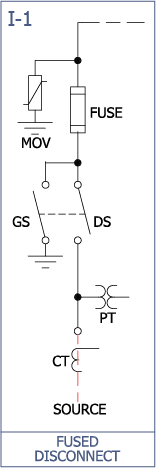
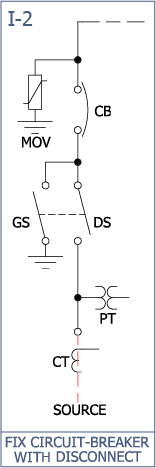
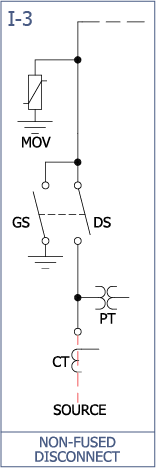
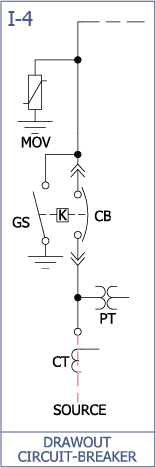

ACCESSORIES FOR INCOMING COMPARTMENT
The following items are available for placement in the incoming compartment.






 CAPACITOR COMPARTMENT CONFIGURATION OPTIONS
CAPACITOR COMPARTMENT CONFIGURATION OPTIONS
The capacitor compartment may consists of one capacitor bank or multiple capacitor stages. A capacitor bank or stage normally consists of the capacitors, capacitor fuses, and where applicable, a switching device and transient inrush reactors. Typical bank or stage configuration options are provided below. The capacitor bank/stage compartment is compartmentalized and isolated from the incoming compartment to allow for maintenance and repair.
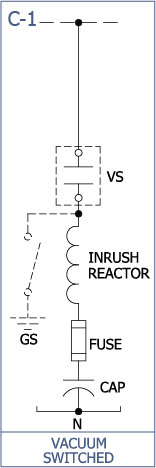
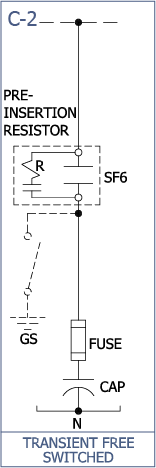
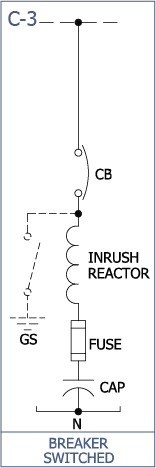
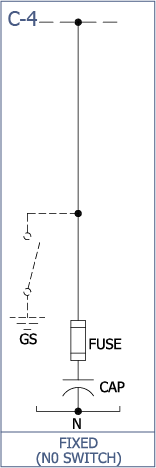
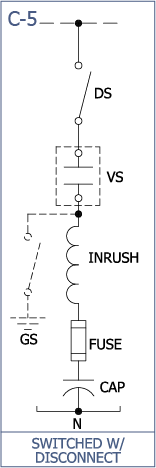
 CAPACITOR BANK/STAGE CONNECTION
CAPACITOR BANK/STAGE CONNECTION
The capacitor bank can be connected in a number of different ways depending upon bank rating and protection requirements. Typically, banks are provided with an ungrounded wye or ungrounded split-wye connection, but a grounded wye and Delta connection are also available.
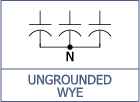
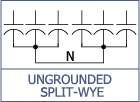
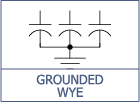
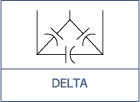
Component selection is based on specified control and protection requirements, power capacitor bank configuration, short circuit requirements, voltage, BIL, reactive power rating, frequency, costs, and NEPSI's experience with component quality and reliability. The following list provides key components and features commonly supplied by NEPSI.
Click each of the headings below to learn more about our commonly used components
 INCOMING COMPARTMENT
INCOMING COMPARTMENT
Air Disconnect Switch
Externally operated chain-drive operated 3-pole air-disconnect switch to provide a "visible-break" and electrical isolation of the power capacitor bank during maintenance and repair.
Ground Switch
Externally operated chain-drive or direct-drive operated 3-pole ground switch to ground the load-side terminals of the incoming air-disconnect switch, breaker, and/or capacitors for safety during maintenance. The ground switch is key interlocked with the upstream disconnecting device to prevent closing of the ground switch onto a live bus.
Main Incoming Fuses
Main incoming current limiting fuses (with local and remote blown fuse indication) for short circuit protection of the power capacitor bank.
Main Incoming Breaker
Main incoming drawout or fixed-mounted circuit breaker for protection, isolation, and switching of the power capacitor bank.
Lightning Arresters
Lightning arresters are provided as standard on NEPSI's equipment to protect the power capacitor bank and incoming cables from lightning and switching transients.
Control Power Transformer(s) (CPT)
Control power transformers to supply control power and voltage sensing to the capacitor bank's, metering, protection, and control system.
Current Transformers (CT)
Current tranformers to supply a current signal for the capacitor bank's metering, protection, and control system.
Bus Duct Entry
Bus duct entry to allow for direct bus connection to switchgear.
Dead-Front Entry
Dead-front design entry that allows for 200 amp and 600 amp separable elbow connectors.
Roof Bushing Entry
Roof bushing entry to allow for direct connection to overhead bus within substations.
 CAPACITOR COMPARTMENT
CAPACITOR COMPARTMENT
Capacitors
Low loss, double bushing capacitors that meet or exceed IEC 871, IEEE 18 and CSA standards. Capacitors are typically connected ungrounded-wye or ungrounded split-wye. Internal discharge resistors reduce the residual voltage to less than 50 volts within 5 minutes of de-energization. The dielectric fluid is environmentally friendly, biodegradable, non PCB, with low toxicity. Internally fused capacitors are available upon request.
Capacitor Fusing
Capacitors are individually fused with current limiting fuses. These fuses reduce the possibility of case rupter on capacitor failure and allow the power capacitor bank to continue to operate when a capacitor fails. The fuses are equipped with blown fuse indicators and can also be equipped with direct fuse operation sensors for blown fuse detection.
Capacitor Switches
Single stage and multi-stage power capacitor banks are equipped with vacuum contactors (for voltages less than 6.6kV), capacitor switches, or circuit breakers (fixed or drawout) for capacitor switching.
Transient Inrush Reactors
NEPSI's TI-Reactors™ are provided on multi-stage power capacitor banks to limit the frequency and magnitude of inrush currents associated with back-to-back capacitor bank switching. These reactors are required to prevent premature capacitor switch or breaker failure and are sized by NEPSI.
Current Transformers
Multi-stage capacitor banks can be equipped with stage current transformers to allow for metering and protection of individual stages.
Air Disconnect Switch
Externally operated, key interlocked, 3-pole air-disconnect switch(s) that isolates a single stage of a multi-stage capacitor bank, allowing for partial bank operation during maintenance.
Ground Switch
Externally operated, key interlocked, 3-pole ground switch(s) that grounds the capacitor terminals to ensure all trapped charge has been removed from the capacitors.
 CONTROL AND PROTECTION COMPARTMENT
CONTROL AND PROTECTION COMPARTMENT
Automatic Capacitor Bank Controllers
Automatic Power Capacitor Banks are equipped with various types of controllers to automatically turn power capacitor banks (stages) on and off based on var flow, watt flow, voltage level, current-flow, time-of-day, or day-of-week. Controllers are integrated with the protection system and other components to form a fully integrated system.
Protection
Power Capacitor Banks can be equipped with various protection relays, meters, and sensors to protect the capacitor bank as well as the system from over-voltage, out-of-balance operation from capacitor failure, internal faults, and over-temperature due to fan failure. Protection devices are integrated with the control system and other components to form a fully integrated system.
Logic Controllers (PLC, Smart Relays)
Various logic controllers are available to provide auxiliary control functions such as timing, interlocking, blocking, and permissives. Controllers also provide a communication gateway between plant DCS systems and the power capacitor bank.
Arc Flash Mitigation
See NEPSI’s technical note on arc flash mitigation in metal-enclosed capacitor banks and harmonic filter banks. This technical note provides over 30 mitigation strategies available from NEPSI to minimize the level of exposure to arc flash events as well as ways to reduce the probability that an arc flash event will occur in the first place.
 MISCELLANEOUS
MISCELLANEOUS
Enclosure
Free standing, compartmentalized, all welded, 11 gauge galvanneal steel construction with 3 point pad-lockable latching handles and stainless steel hinges. The enclosure is painted with Engineered Siloxane, a Marine paint with rated salt spray of 5500 hours. NEMA 3R (IP64) construction is standard, NEMA 12 (IP65) and 4X (IP66) are available as an option. Base of enclosure as well as capacitor supports are formed from C4 structural steel. Door stays and windows are standard.
Key Interlock System
As standard, a key interlock system is provided that dictates proper sequence of operation and safe entry into the enclosure. Upstream devices may be included in the interlock sequence.
Ground and Phase Bus
A 1/4" X 2" Tin plated ground bus (or Silver when specified) is provided through the width of the enclosure to assist in grounding during maintenance. All phase bus is rated at a minimum of 135% of the bank nominal current rating.
NEPSI's Metal-enclosed Capacitor Banks can be furnished with an integrated protection system that is located in an isolated compartment that is integral with the capacitor bank enclosure, or be located remotely in an E-house or control room. Whether integrally mounted, or remotely located, NEPSI’s protection systems are completely tested, set, and calibrated at the factory before shipment.
All Shunt Capacitor Banks need to be protected from abnormal conditions that are both external and internal to the capacitor bank. External conditions that may be destructive to the capacitor bank can arise from over/under voltages, faults, and harmonic distortion. Internal conditions can be from internal faults, failed capacitors, harmonic resonance, and over temperature. The need to protect for these conditions must be considered when purchasing a capacitor bank.
The Table below summarizes the protections that are available from NEPSI. Depending on configuration of the incoming compartment, (see the configure tab) some of these protections may not be applicable and would need to be provided by the upstream switchgear.
The recommended protections are as follows:
PROTECTION TYPE |
DESIGNATION |
PROTECTION DESCRIPTION |
|---|---|---|
| Short Circuit and Overcurrent Protection |
50/51 50/51G |
Short Circuit and Overcurrent protection needs to be provided either as part of the capacitor bank or upstream by the customer. This protection is provided by current limiting fuses or by a circuit breaker with associated relaying. |
| Over-Voltage | 59 | To detect an overvoltage condition that could result in capacitor failures and to reduce supply voltage by turning the bank off. Typically an over voltage relay with multiple set points is provided to first alarm and take corrective action, and if necessary then trip if an overvoltage persist. |
| Under-Voltage | 27 | To detect an under voltage condition to disconnect the bank if required due to trap charge on re-energization or to protect the upstream device that will be restoring power. |
| Neutral Unbalance (Blown Fuse Detection) |
59N or 51N or 51G or Direct |
To detect a capacitor fuse operation. For ungrounded banks with 4 or less capacitors per phase, continued operation with a capacitor out of service could result in over-voltages on the remaining capacitors. Some means of blow fuse detection should be provided. |
| Harmonic Voltage & Current Distortion |
Ithd, Vthd | Protection against harmonic resonance that can result in high currents or voltages due to resonance. |
| Over-Temperature | 26 | Over-temperature detection to protect capacitor cells in the event of an over temperature condition due to a fan failure or improper air flow. |
| Arc Flash Protection | -- | ABB UFES System; arc flash protection relay and ultra fast earthing switch to eliminate arcing faults in less than 4 mS. See NEPSI’s arc flash mitigation document for further details on arc flash mitigation. |
PROTECTION EXAMPLES
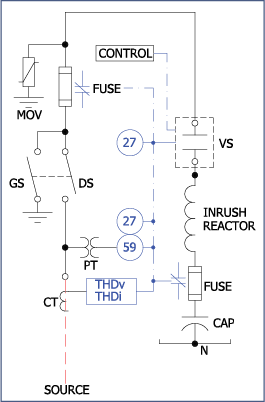
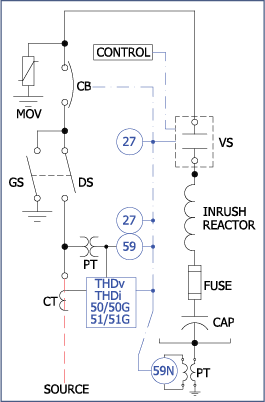
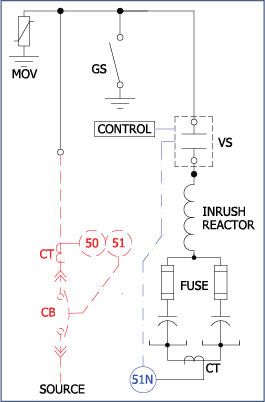
NEPSI's Metal-enclosed Capacitor Banks can be furnished with an integrated control system that is located in an isolated compartment that is integral with the capacitor bank enclosure, or be located remotely in an E-house or control room. Whether integrally mounted, or remotely located, NEPSI’s control systems are completely tested, and set at the factory to ensure easy, and problem free installation and commissioning.
The control system normally consists of a program logic controller (PLC) and other metering, control, comunication, and indicaton devices that are necessary for the safe and proper operation and monitoring of the capacitor bank. The table below provides the more common control features and options provided by NEPSI.
CAPACITOR BANK CONTROL OPTIONS |
|---|
| Power Factor Control |
| Var Control |
| Voltage Control |
| Remote / SCADA Control |
| Manual Control |
| Time-of-Day |
| Day-of-Week |
TYPICAL CONTROL FEATURES |
|---|
| On/off indicators for all switching devices |
| On/Off/Auto Control Switches for each capacitor stage |
| Local/Remote Switches |
| Circuit Breaker Control Switches |
| 5-minute discharge timers |
| Power quality meters |
| Control inputs for prohibiting improper bank operation |
| Control Power Circuit Breaker |
| Key and electrical interlocks |
| Lights |
| Strip Heaters |
| Thermostatically controlled exhaust fans |
| Shorting Switches/blocks for all current transformers |
PRODUCT LITERATURE |
|||
| Metal-Enclosed Power Capacitor Banks | |||
| Transient Inrush Reactors | |||
| ABB DS1 Transient Free Switching Technology |
HELPFUL INFORMATION AND TOOLS |
|||
| Technical Notes | |||
| Calculators | |||
| Arc Flash Hazard Mitigation in Metal-Enclosed Power Capacitor Banks and Harmonic Filter Banks |

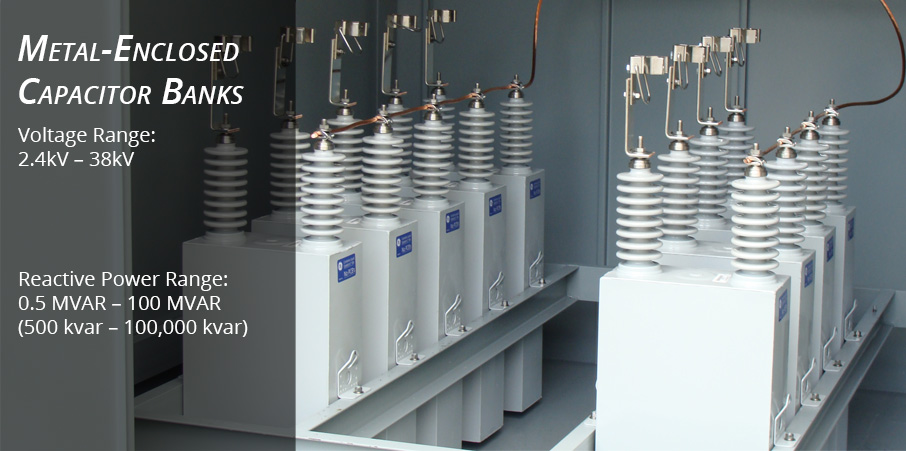
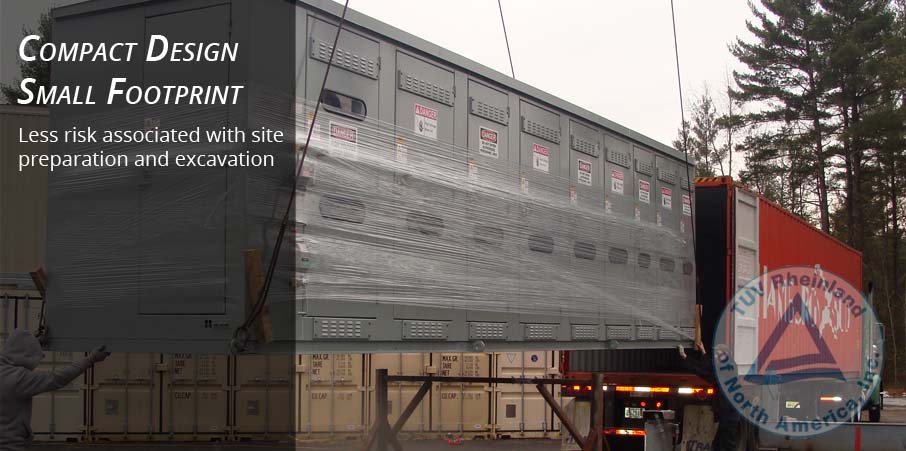
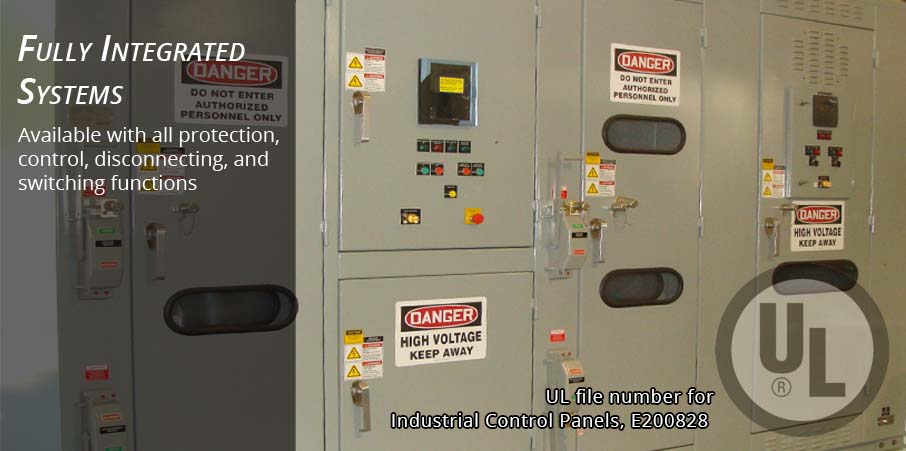
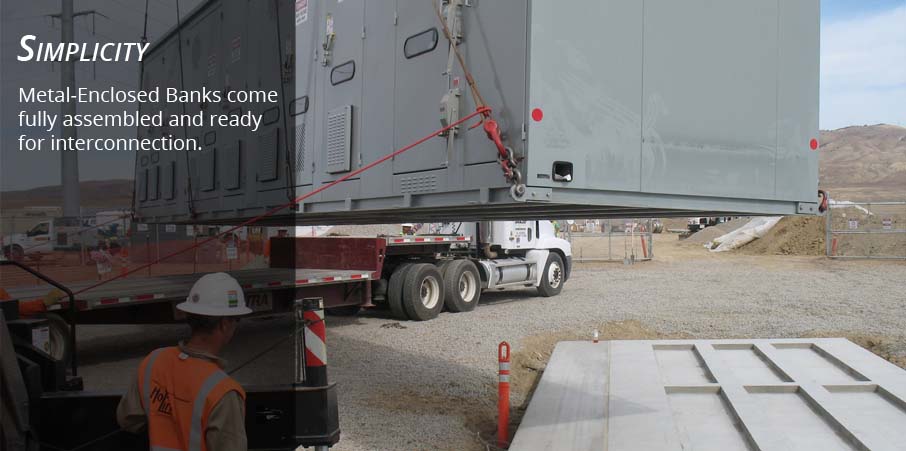
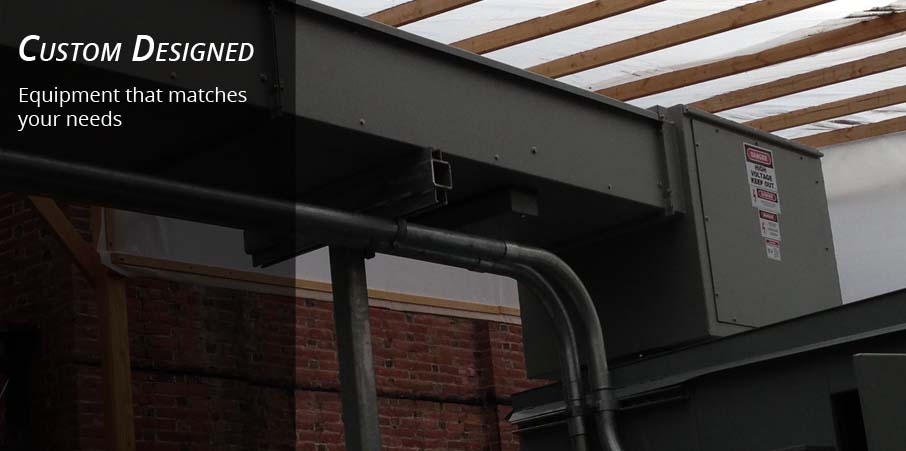


Follow us on social media for up-to-date news, videos, and other information: